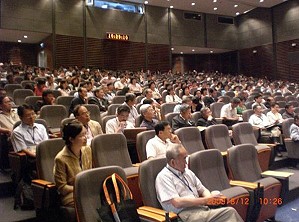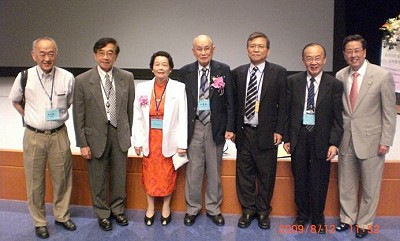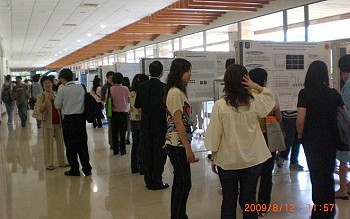NHRI Communications

會議報導
九十八年度國家衛生研究院生物醫學學術研討會紀實
NHRI reports on 2009 Biomedical Research Symposium
 九十八年度國家衛生研究院生物醫學學術研討會(2009 Biomedical Research Symposium of NHRI)於今年8月12日至13日假本院會議中心舉行。此次會議參與人員除有整合性計畫研究人員外,並邀請參與院外計畫學術審查之國內、外專家約60位共同與會,另開放本院研究人員及國內各機構研究人員報名與會,總計人數達約400人次,可謂盛況空前,充分達到學術交流之目的。
九十八年度國家衛生研究院生物醫學學術研討會(2009 Biomedical Research Symposium of NHRI)於今年8月12日至13日假本院會議中心舉行。此次會議參與人員除有整合性計畫研究人員外,並邀請參與院外計畫學術審查之國內、外專家約60位共同與會,另開放本院研究人員及國內各機構研究人員報名與會,總計人數達約400人次,可謂盛況空前,充分達到學術交流之目的。本院自97年起,於每年8月暑假期間,藉由辦理涵蓋各領域的國際學術研討會方式與國內外學者進行交流,除了展現本院當年支持的院內、外研究成果,更冀望成為國內外生醫學界朋友在暑期積極參與的學術盛事。
 此次會議首日上午由本院伍焜玉院長主持開幕,向所有與會者簡介本院成立的宗旨、各研究單位的設立沿革、現今研究的方向及未來發展的重心。隨後進行贈獎儀式,由本院伍院長致贈刻有「貢獻殊偉」的感謝獎牌予何曼德院士註1,以表彰何院士對本院卓越之貢獻並致感謝之意。何院士於受獎後發表感言,闡述過去為台灣醫學領域所做的努力及心得,字字珠璣,讓與會人員獲益良多(觀看影音檔請按此處)。
此次會議首日上午由本院伍焜玉院長主持開幕,向所有與會者簡介本院成立的宗旨、各研究單位的設立沿革、現今研究的方向及未來發展的重心。隨後進行贈獎儀式,由本院伍院長致贈刻有「貢獻殊偉」的感謝獎牌予何曼德院士註1,以表彰何院士對本院卓越之貢獻並致感謝之意。何院士於受獎後發表感言,闡述過去為台灣醫學領域所做的努力及心得,字字珠璣,讓與會人員獲益良多(觀看影音檔請按此處)。本次會議為期二天,上午時段各規劃一場Plenary Lecture。首日邀請美國匹茲堡大學骨科骨骼肌肉研究中心/生物工程系教授胡流源院士以「Bioengineering and Its Importance in Keeping our Joints Healthy註2」為題發表演說;次日上午則邀請本院分子與基因醫學研究組王陸海組主任以「Molecular Signaling Regulating Oncogenic Properties of Cancer Cells註3」為題發表演說。
 本次會議另規劃「Medical Engineering」、「Population Health Research」、「Cancer Research」及「Biomedical Science」四項口頭報告主題,邀請執行成果優良之整合性醫藥衛生科技研究計畫主持人及國衛院研究人員共計16位進行口頭報告,分享其研究成果與經驗,促進學術交流及研究合作。
本次會議另規劃「Medical Engineering」、「Population Health Research」、「Cancer Research」及「Biomedical Science」四項口頭報告主題,邀請執行成果優良之整合性醫藥衛生科技研究計畫主持人及國衛院研究人員共計16位進行口頭報告,分享其研究成果與經驗,促進學術交流及研究合作。另由於口頭報告場次有限,本次會議另安排兩個壁報時段(Poster Session),由整合性計畫主持人及本院研究人員張貼壁報展示研究成果(共計發表127篇壁報論文),並於第二天下午特別安排分組壁報論文討論會議(Poster Discussion Meeting),以利發表者與學術審查會各組委員間進行交流與互動,有助於委員了解計畫執行成效,並協助解決可能遭遇之困難,促進整合性計畫主持人、本院研究人員及各領域專家學者之交流與互動,進而達到研究合作及團隊形成之目標。
本次會議的演講、壁報論文發表及分組討論皆引起熱烈的問答討論,往往欲罷不能,其間的腦力激盪必定使所有與會者皆獲益良多。
註1:何曼德院士自民國81年起即參與院外整合性醫藥衛生研究計畫之推動,陸續擔任學術審查委員及諮議委員,直至95年始以高齡為由請辭。十餘年間不僅協助本院建立一套完整及嚴謹的計畫審查制度,使其成為本院之特色,更對提昇全國醫藥衛生研究水準有重要貢獻。另一方面,何院士在本院草創時期即參與本院規劃事宜,85年至96年間連任4屆本院諮詢委員,對本院之創建及發展茁壯卓有貢獻。86年,何院士在本院吳成文創院院長力邀下,返台擔任本院臨床研究組(現已改名為感染症研究組)首任組主任,任職期間(86-90年)致力於臨床感染症專科醫師訓練(培育了四十多位臨床感染症醫師)及進行抗生素抗藥性監測相關研究計畫,不遺餘力,實為本院研究人員的表率。87年,台灣爆發第一波腸病毒嚴重疫情,何院士結合了不同學術研究及醫療機構建立的研究團隊,找出腸病毒71型病原,適時讓疫情獲得掌控。何院士當時還在本院臨床研究組成立了「微生物研究諮詢實驗室」,推動「台灣抗生素使用及抗藥性監測(TSAR)」相關研究計畫,致力於探討及解決台灣抗生素抗藥性相關問題,其研究成果促成政府正視國內抗生素濫用狀況,並成功地使門診的抗生素使用獲得改善,對國內感染症醫學研究及細菌抗藥性控制貢獻卓著。
註2:胡流源院士演講摘要
Bioengineering and Its Importance in Keeping Our Joints Healthy
Ligaments and tendons are parallel-fibered soft connective tissues that are well designed to resist tensile loads. They have unique nonlinear tensile properties. At low loads, their relatively low stiffness serves to stabilize and guide the diarthrodial joints to move smoothly. At higher loads, their stiffness increases, and thus, can help to limit excessive motion between the bones in order to protect other soft tissues in and around these joints from being damaged. Thus, ligaments and tendons play a very important role in keeping our joints healthy.
Unfortunately, injuries to ligaments and tendons occur frequently during work- and sports-related activities, and the incidence has increased over the last few decades. It is estimated that tendon injuries account for 30% to 50% of all sports-related injuries. Tendinopathies are so ubiquitous that they occur in over 48% of occupationally induced musculoskeletal ailments. The incidence of knee ligament injuries is estimated to be 2 in 1,000 people per year in the general population―translating to over 200,000 and 150,000 anterior cruciate ligament (ACL) and medial collateral ligament (MCL) tears per year, respectively, in the U.S alone. The same could be said about the tendons and ligaments in and around the shoulder.
Patients with tendon and ligament ailments demand quick return to work and sports.However, as investigators, physicians and, medical personnel are well-aware, these tissues heal and repair very slowly. As such,the healing ligaments and tendons lack the biomechanical properties to perform their normal function; thus, significantly elevating the potential of damaging other tissues,the articular cartilage, in particular. As a result, there is a dire need to better understand the normal function of tendons and ligaments, the mechanisms of their injuries, and the healing and remodeling processes in order to find better treatment strategies to accelerate their recovery.
In this lecture, we first present the fundamental work done during the last 40 years on the anatomy and biology of ligaments and tendons, as well as describing specially developed methodologies to accurately determine their biomechanical properties and function. We then highlight biological factors that would cause changes to tissue properties in-vivo. To complete the picture, we include the importance of their time- and history-dependent properties based on Professor Y.C. Fung's quasi-linear viscoelastic theory.
It can be easily visualized that the field of biomechanics has made great strides in better understanding the function of ligaments and tendons as well as in finding new and improved treatment of their injuries. As a result, many patients have benefited. Examples on how to better treat a complete tear of the MCL of the knee, as well as how to improve ACL reconstruction procedures by means of robotics technology are presented in detail. With the advent of functional tissue engineering, the use of growth factor and cytokines as well as cells for ligament and tendon healing are interesting and timely topics to be discussed. In addition, the use of biological scaffolds (e.g. extracellular matrix (ECM) bioscaffolds, such as porcine small intestinal submucosa) have shown translational potential and examples of how they may be applied to improve the healing and regeneration of the MCL and the patellar tendon (PT) are presented. Finally, novel ECM hydrogels that can retain important bioactive agents have been fabricated and injected and used together with ECM bioscaffolds to act synergistically as a biological augmentation to successfully heal the ACL; thus, providing a novel approach for treatment of the most serious problem in orthopaedic sports medicine.
In our research center, in-vitro cyclic stretching and cell seeding of ECM bioscaffolds have been utilized to produce better aligned neo-collagen. Novel processing techniques, including electrospinning, can be used to synthesize bioscaffolds with highly aligned fiber morphology―an optimal structure to promote enhanced ligament and tendon healing. For the future, we have identified exciting areas in molecular and cellular bioengineering that would further enhance our knowledge on the mechanism of healing of these tissues, and therefore, bringing tissue regeneration within the realm of possibility.
It is also time to move our focus towards in-vivo studies to better understand the injury mechanisms of ligaments and tendons. As it is possible to use biplanar fluoroscopy to collect in-vivo kinematics data to within 0.1 mm & 0.1° accuracy, we can reproduce these data on cadaveric knees utilizing the robotic/UFS testing system to learn about the in-situ forces in these tissues. Moreover, in-vivo kinematics can be integrated into computational models to calculate the in-situ forces in the same tissues. Once the computational models are validated, they can be used to predict the function of ligaments and tendons under more complex external loading conditions, to better understand their injury mechanisms and to properly evaluate new and improved treatment procedures on a scientific basis.
Thus, it is easy to see that ligament and tendon research has reached an exciting period of time. On the other hand, we must recognize that there is still a long way to go. Translating molecular and cellular responses to in-vivo conditions and clinical applications will take hard work and ingenuity as the biology is extremely complex. We suggest that it will require an interdisciplinary and multidisciplinary research team to work together to accomplish these goals. We are optimistic that many biologists, biochemists, clinicians, bioengineers and other scientific disciplines (i.e. mathematicians, statisticians, immunologists, and so on) recognize the need to work together in a seamless manner to find new ways to regenerate injured ligaments and tendons to their normal state so that patients will be able to resume their normal daily as well as sports activities while keeping their joints healthy.
註3:王陸海組主任演講摘要
Molecular Signaling Regulating Oncogenic Properties of Cancer Cells
The purpose of this study is to explore the genes and signaling pathways important for regulating various oncogneic properties of cancer cells with emphasis on their survival and invasive abilities. For this purpose, we selected from low invasive human breast cancer lines MCF-7 and MDA-MB453 to derive their respective highly invasive lines. Those pairs of lines were subjected to cDNA and miRNA array analysis, as well as comparison of various signaling pathways known to be relevant for oncogenic properties of tumor cells. Among the genes shown to be differentially expressed or activated, we observed increased expression of Twist and AKT2, as well as activation of STAT3 in the invasive but not in the parental lines. Co-expression of these molecules was further examined for signaling and functional linkage. Our results indicated that STAT3 bound to Twist promoter and activated its transcription, Twist in turn bound to AKT2 promoter to activate AKT2 transcription. The STAT3-Twist-AKT2 signaling axis plays an important role in regulating breast cancer cell anchorage independent growth, migration/invasion and resistance to paclitaxel. Co-expression of Twist and AKT2 as well as increased P-STAT3 and Twist was found in most of the late stage breast cancer specimens. Furthermore, a number of miRNAs were found to be differentially expressed in the parental and invasive cells. Their functional significance and potential target genes relevant to maintenance of the oncogenic properties are being investigated.
In conclusion, we have identified STAT3-Twist-AKT2 signaling pathway to be important in regulating invasion and survival of breast cancer cells, and these molecules could serve as the prognosis markers and potential drug targets for cancer treatment.
《文/圖:學發處蕭振祥》